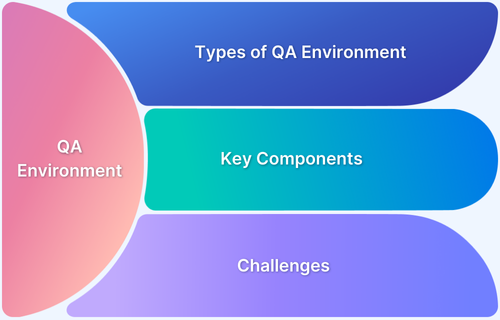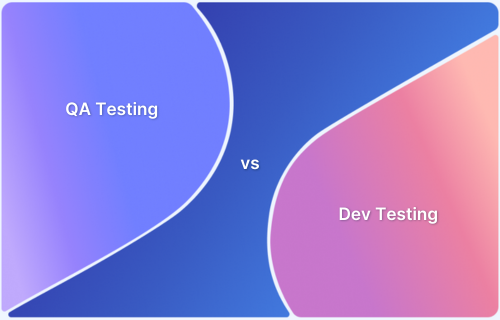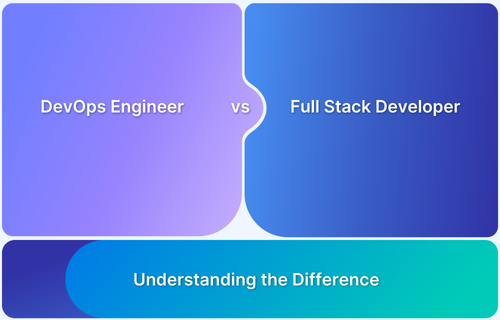Quality Assurance (QA) and Software Testing are integral to the Software Development Life Cycle (SDLC), each contributing to the delivery of reliable and high-performing software. While both aim to uphold product quality, they serve fundamentally different purposes.
Overview
Quality Assurance is a process-oriented discipline aimed at preventing defects, while Software Testing is a product-oriented activity focused on detecting defects.
QA vs Software Testing
Here’s how QA and Software Testing differ across key aspects:
Focus
QA concentrates on enhancing and managing the development process to ensure quality is built in from the start, whereas Software Testing focuses on evaluating the final product to catch defects that slipped through.
Objective
The primary goal of QA is to prevent defects by establishing robust processes; on the other hand, Testing aims to uncover defects by executing and evaluating the software.
Approach
QA takes a proactive stance, emphasizing prevention through process design, audits, and continuous improvement, while Testing follows a reactive approach, triggered once code is available for validation.
Techniques Used
QA relies on methodologies like process audits, reviews, and quality models (e.g., ISO, CMMI), whereas Testing employs tools and techniques like manual testing, automation, and various test levels (unit, integration, system).
Time of Involvement
QA is integrated throughout the SDLC, starting from the requirements phase, whereas Testing is typically concentrated toward the later stages, especially after development activities.
This article explores the primary differences between Quality Assurance and Software Testing, highlighting their roles, approaches, and impact on the software development process.
Difference between Software Testing and Quality Assurance
The table below provides a quick comparison of Quality Assurance and Software Testing across key factors:
| Aspects | Software Testing | Quality Assurance |
|---|---|---|
| Responsibilities | Focuses on identifying and fixing issues in the software product. | Ensures processes conform to quality standards throughout the development lifecycle. |
| Techniques | Uses methods such as unit testing, integration testing, system testing, etc. | Applies quality management practices like planning, audits, process improvement, and reviews. |
| Output | Produces defect reports, test plans, and test execution results. | Generates quality metrics, audit reports, process documentation, and improvement plans. |
| Time | Typically performed after development phases, especially post-coding. | Active throughout the SDLC, starting from requirement gathering to delivery. |
| Effort | Depends on the complexity of the software and depth of testing required. | Involves ongoing effort in planning, coordinating, and monitoring quality activities. |
| Cost | Includes expenses for tools, test environments, and testing personnel. | Covers process setup, training, quality audits, and cost of rework due to process failures. |
It’s important to recognize that Quality Assurance encompasses a broader set of activities aimed at ensuring the overall effectiveness of the software development process. In contrast, Software Testing focuses specifically on verifying the performance and functionality of the product.
Understanding the distinction between the two is crucial, as both testing and assurance play equally vital roles in delivering reliable, high-quality software.
To support this dual approach, BrowserStack Test Management provides a unified platform that helps teams collaborate seamlessly, manage test workflows efficiently, and maintain full visibility across QA and testing efforts, all in one place.
What is Quality Assurance (QA)?
QA is a process-oriented approach that includes defining, improving, and ensuring adherence to best practices, standards, and procedures throughout the software development lifecycle.
QA involves activities such as process audits, quality planning, documentation reviews, training, and continuous improvement initiatives.
Instead of directly evaluating the final product, QA focuses on refining the development processes to ensure they are efficient and effective, resulting in more stable and dependable software.
Purpose of QA
The primary purpose of Quality Assurance includes:
- Finding and fixing problems before they become major ones and avoiding hazards at the outset of production.
- Creating and enforcing processes, procedures, and strategies to ensure high quality.
- Maintaining conformity with established norms and policies in the field.
- Enhancing the efficacy and productivity of the software creation cycle.
Features of QA
QA is defined by several key traits that shape how it functions within the development lifecycle:
- Process-Oriented: Focuses on refining and optimizing processes rather than just the end product.
- Preventive Approach: Aims to identify and eliminate potential issues before they become defects.
- Standards-Driven: Relies on adherence to industry and organizational standards (e.g., ISO, CMMI).
- Continuous Monitoring: Involves regular reviews, audits, and assessments of development activities.
- Documentation-Based: Emphasizes creating and maintaining records of quality plans, procedures, and audits.
- Cross-Functional: Collaborates across teams (developers, testers, managers) to uphold quality standards.
Read More: What is QAOps? (With Methodologies)
Advantages of QA
Implementing QA offers multiple benefits that contribute to the success and stability of software projects:
- Early Defect Prevention: Reduces the chances of defects by improving processes from the start.
- Cost Efficiency: Saves long-term costs by avoiding rework and post-release fixes.
- Improved Product Quality: Leads to more reliable, stable, and user-friendly software.
- Better Process Visibility: Promotes transparency and accountability within development teams.
- Regulatory Compliance: Ensures adherence to legal requirements and industry standards.
- Customer Satisfaction: Increases user trust and satisfaction through consistent software quality.
Limitations of QA
Despite its benefits, QA also has certain limitations that teams should be aware of:
- Initial Overhead: Requires time and resources to set up processes, tools, and training.
- Not a Substitute for Testing: QA cannot completely eliminate the need for product-level testing.
- Dependent on Team Discipline: Its effectiveness relies heavily on consistent process adherence.
- Slower Iteration in Fast-Paced Environments: Can be seen as restrictive in agile or rapid-release settings if not adapted properly.
- Measurement Challenges: The impact of QA is sometimes harder to quantify compared to direct defect detection in testing.
Skills of QA Manager
To lead quality efforts effectively, a QA Manager must have a mix of technical, analytical, and leadership skills, including:
- Expertise in quality assurance theory and practice.
- Ability to effectively organize tests, create test cases, and run those tests.
- Ability to quickly diagnose and resolve quality concerns through rigorous analysis and problem-solving skills.
- Able to effectively communicate and lead quality assurance teams.
- Careful planning and execution are essential for successful testing and regulatory conformance.
- Familiarity with the rules and requirements of the software business.
- Proficiency with test automation frameworks as well as test management technologies.
- Constantly expanding one’s knowledge and familiarity with contemporary techniques and tools for quality assurance.
What is Software Testing?
Software Testing is a product-focused activity aimed at evaluating a software to identify defects, ensure functionality, and verify that it meets specified requirements. It involves executing the software under controlled conditions to detect errors, bugs, or unexpected behavior before it reaches end users.
Testing can be manual or automated and spans various levels, such as unit testing, integration testing, system testing, and acceptance testing. The core goal of Software Testing is to validate the quality of the final product and confirm that it behaves as expected in real-world scenarios.
Purpose of Testing
The purpose of software testing can be understood through its primary objectives:
- Identifies and fixes bugs and defects before the software is released to the public, ensuring a stable and reliable product.
- Ensures the final product is bug-free and performs as expected across various scenarios and use cases.
- Simulates real-world conditions, such as high traffic or limited system resources, to test the software’s efficiency and performance under stress.
- Focuses on functionality and user satisfaction, ensuring the software meets user expectations and delivers a smooth experience.
- Enhances dependability and stability by uncovering issues that could lead to system crashes, data corruption, or operational failures.
Features of Testing
Software Testing is defined by several core features that guide its execution and value:
- Defect Detection: Identifies bugs, errors, or deviations from expected behavior.
- Requirement Validation: Ensures that the software meets functional and non-functional requirements.
- Execution-Based: Involves running the software in test environments.
- Objective Assessment: Provides measurable insights through test reports, metrics, and coverage.
- Repeatable: Testing can be automated for consistency and efficiency over time.
- Layered: Includes multiple levels like unit, integration, system, and acceptance testing.
Read More: Top 10 Skills of a Proficient QA Manager
Advantages of Testing
Here are the main benefits that software testing brings to the development process:
- Improves Software Quality: Detects issues early, leading to more stable and reliable products.
- Enhances User Experience: Ensures the application performs as expected under real use cases.
- Reduces Risk: Prevents major failures post-release, protecting reputation and user trust.
- Supports Continuous Delivery: Enables frequent, safe releases in agile environments through automated testing.
- Provides Documentation: Offers detailed reports and logs useful for debugging and future development.
Limitations of Testing
Despite its importance, testing has certain limitations that development teams should consider:
- Cannot Guarantee a Bug-Free Product: Testing reduces defects, but cannot eliminate all of them.
- Resource-Intensive: Requires time, tools, skilled personnel, and infrastructure.
- Dependent on Test Coverage: Missed test cases or poor coverage can lead to undetected issues.
- Late Detection in Some Cases: If testing starts too late, it may miss process-level issues that QA would catch.
- Maintenance Overhead: Automated tests need regular updates as the software evolves.
Difference between Quality Assurance and Software Testing
Though closely related, QA and testing serve distinct roles in the development lifecycle. Here’s how they differ across several dimensions:
Scope
Quality Assurance ensures the software development process follows established standards and best practices, guiding how the product is planned, built, and maintained.
In contrast, Testing is a subset of QA, concerned with evaluating the actual software product to identify defects and ensure its functionality, reliability, and performance.
Objective
The objective of QA is to establish and maintain a quality management system that delivers high-quality output across projects.
Testing, on the other hand, aims to detect and fix bugs in code or final products, ensuring the software meets all specified requirements and performs as intended.
Timing
QA practices are integrated throughout all stages of the software development lifecycle, starting from requirement gathering to release and maintenance.
Testing typically takes place after development phases, during specific test cycles such as unit testing, integration testing, system testing, and user acceptance testing.
Functions and Responsibilities
QA teams concentrate on maintaining process quality and ensuring development practices are structured to prevent problems before they occur.
Testing teams are responsible for executing test cases and identifying defects in the product. Clearly distinguishing these responsibilities helps avoid overlap, reduce gaps, and ensure complete quality coverage.
Global Quality Management
Understanding the difference between QA and Testing supports a comprehensive quality management strategy. QA encompasses more than just the testing phase, it covers process control, documentation, audits, and continuous improvement, enabling organizations to reduce defects at every level.
Efficient Test Planning
By separating QA and Testing responsibilities, teams can plan tests more strategically. QA helps determine the scope, type, and depth of testing required. This enables more accurate resource allocation, saving time, cost, and effort.
Improved Team Collaboration
A clear distinction between QA and Testing promotes stronger collaboration and communication. When both teams understand their roles and how they contribute to the larger goal of quality, it leads to better coordination, smoother workflows, and a higher-quality final product.
Read More: Myths about QA Testing you need to know
Software Testing vs Quality Assurance: Which one to opt for?
The decision between prioritizing Quality Assurance (QA) and Software Testing should be guided by the specific needs of the project or organization. Before making a choice, consider the following factors:
- Scope of Activities: QA involves a broader set of activities, including quality planning, process improvement, training, and audits. In contrast, Software Testing focuses on detecting defects by executing test cases and validating software behavior.
- Project Requirements: If a project demands in-depth validation of functionality, performance, and reliability, Software Testing becomes essential to ensure the software meets its objectives under various conditions.
- Project Complexity and Resources: For smaller projects with limited timelines and resources, emphasizing Software Testing may be more practical. Larger, complex initiatives may benefit from integrating a full QA approach to manage risk and maintain consistency.
- Organizational Goals: If the organization aims to establish a culture of quality and drive long-term improvement, investing in QA is strategic. However, if the focus is on rapid delivery and immediate issue resolution, Software Testing may take precedence.
Platforms like BrowserStack Test Management can support both automated and manual testing by offering test creation, execution, tracking, and real-time dashboards. It streamlines workflows and improves visibility across the QA and Testing process.
Key features include:
- Unified Test Management: Manage both manual and automated test cases from a single platform.
- AI-Powered Test Case Authoring: Automatically generate test cases from user stories or existing data using AI.
- Two-Way Jira Integration: Synchronize test cases, execution results, and defects with Jira for end-to-end traceability.
- Real-Time Dashboards and Analytics: Access execution trends, defect reports, and test coverage metrics in real time.
- CI/CD and Framework Compatibility: Seamlessly integrates with popular automation frameworks and CI/CD tools.
- Cross-Browser and Cross-Device Testing: Test across a wide range of real devices and browsers in the cloud.
- Manual and Exploratory Session Tracking: Capture and log exploratory and manual testing sessions with detailed insights.
Conclusion
Quality Assurance and Software Testing are both essential components of a successful software development strategy, but they serve different purposes.
QA focuses on building quality into the process, ensuring that the right methods and standards are followed throughout the development lifecycle. Testing, on the other hand, evaluates the final product, identifying defects and verifying that the software performs as expected.
Understanding the distinction between the two allows teams to allocate resources wisely, improve efficiency, and deliver high-quality software consistently. Rather than choosing one over the other, organizations should strive for a balanced approach, where QA lays the foundation for quality and Testing reinforces it through validation.
Incorporating both disciplines thoughtfully ensures better collaboration, fewer defects, faster delivery cycles, and ultimately, greater user satisfaction.
FAQs
1. Is Quality Assurance and Testing the same?
No, Quality Assurance (QA) and Testing are not the same. QA is process-oriented, focusing on preventing defects through proper planning, standards, and continuous improvement. Testing is product-oriented, aiming to detect defects in the software by executing it under various conditions. They are related but serve different purposes in the software development lifecycle.
2. Does Quality Assurance include Testing?
Yes, Testing is considered a part of the broader QA process. While QA encompasses a range of activities such as quality planning, audits, and process control, testing specifically involves executing the software to find defects and verify functionality. Testing supports QA by providing feedback on whether the product meets its defined quality standards.
3. Why is it important to distinguish between QA and Testing?
Understanding the distinction helps in allocating roles, resources, and responsibilities effectively. It ensures that quality is built into the process from the start (QA) and validated in the final product (Testing), resulting in fewer defects, improved collaboration, and better outcomes.
4. Can an organization succeed with only Testing and no QA?
Relying solely on Testing without QA may lead to recurring defects, inconsistent processes, and higher long-term costs. QA provides the structure and discipline needed to prevent issues before they arise. For sustainable quality and scalability, both QA and Testing are essential.







